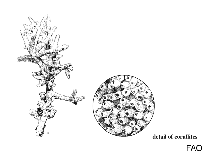Astreopora myriophthalma (Lamarck, 1816)
Porous star coralWarning: DOMDocument::load(): SSL operation failed with code 1. OpenSSL Error messages: error:140770FC:SSL routines:SSL23_GET_SERVER_HELLO:unknown protocol in C:\Apache24\htdocs\includes\SpeciesSummary.lib.php on line 1236
Warning: DOMDocument::load(): Failed to enable crypto in C:\Apache24\htdocs\includes\SpeciesSummary.lib.php on line 1236
Warning: DOMDocument::load(https://sealifebase.nrm.se/webservice/AquaMaps/getAMap.php?genus=Astreopora&species=myriophthalma): failed to open stream: operation failed in C:\Apache24\htdocs\includes\SpeciesSummary.lib.php on line 1236
Warning: DOMDocument::load(): I/O warning : failed to load external entity "https://sealifebase.nrm.se/webservice/AquaMaps/getAMap.php?genus=Astreopora&species=myriophthalma" in C:\Apache24\htdocs\includes\SpeciesSummary.lib.php on line 1236
Mandar um arquivo com seu (sua) Fotos
Imagem do Google | No image available for this species;
drawing shows typical species in Acroporidae.
Imagem do Google | No image available for this species;
drawing shows typical species in Acroporidae.
Classification / Names Common names | Synonyms | CoL | ITIS | WoRMS
| Scleractinia | Acroporidae
Environment: milieu / climate zone / depth range / distribution range Ecologia
Associadas(os) a recifes; intervalo de profundidade 3 - 20 m (Ref. 98471). Tropical; 35°N - 30°S, 32°E - 108°W (Ref. 846)
Distribuição Países | Áreas FAO | Ecossistemas | Ocorrências | Introduções
Indo-Pacific. Tropical to subtropical.
Length at first maturity / Tamanho / Peso / Idade
Maturity: Lm ? range ? - ? cm
Most reef habitats except turbid water (Ref. 846). Carries dense populations of the bivalve L. simplex. Bivalves are completely enclosed by the skeleton. They benefit from the coral through nutrition and protection against predators. The coral's gain, however, is unclear (Ref. 115168).
Life cycle and mating behavior Maturidade | Reprodução | Desova | Ovos | Fecundidade | Larvas
Hermaphroditic (Refs. 113708, 113712). Mature gametes are shed into the coelenteron and spawned through the mouth. Life cycle: The zygote develops into a planktonic planula larva. Metamorphosis begins with early morphogenesis of tentacles, septa and pharynx before larval settlement on the aboral end (Ref. 833).
Referência principal
Referências | Coordenador | Colaboradores
Veron, J.E.N. 2000. (Ref. 846)
Status na Lista Vermelha da IUCN (Ref. 130435)
Segura ou pouco preocupante (LC) ; Date assessed: 03 January 2008
Status no CITES (Ref. 108899)
Appendix II: International trade monitored
CMS (Ref. 116361)
Not Evaluated
Perigo para os humanos
Uso pelos humanos
| FishSource |
Ferramentas
Mais informação
Fontes da internet
BHL | BOLD Systems | CISTI | DiscoverLife | FAO(Publication : search) | Fishipedia | GenBank (genoma, nucleotídeo) | GloBI | Gomexsi | Google Books | Google Scholar | Google | PubMed | Hexacorallians of the World | Árvore da vida | Wikipedia (Ir para, procura) | Registro zoológico
Estimates based on models
Preferred temperature
(Ref. 115969): 25 - 29.3, mean 28.4 (based on 3492 cells).
Categoria de preço
(Ref. 80766):
Unknown.



